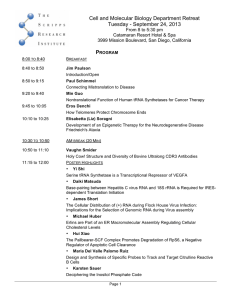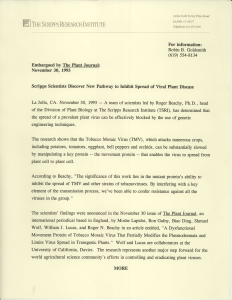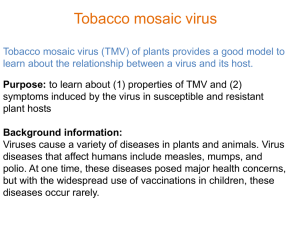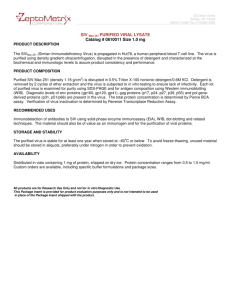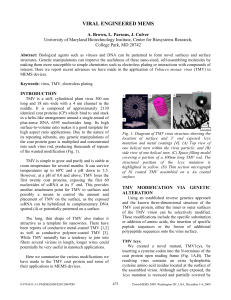Characterization of tobacco mosaic virus isolated from tomato in India Shoba Cherian
advertisement
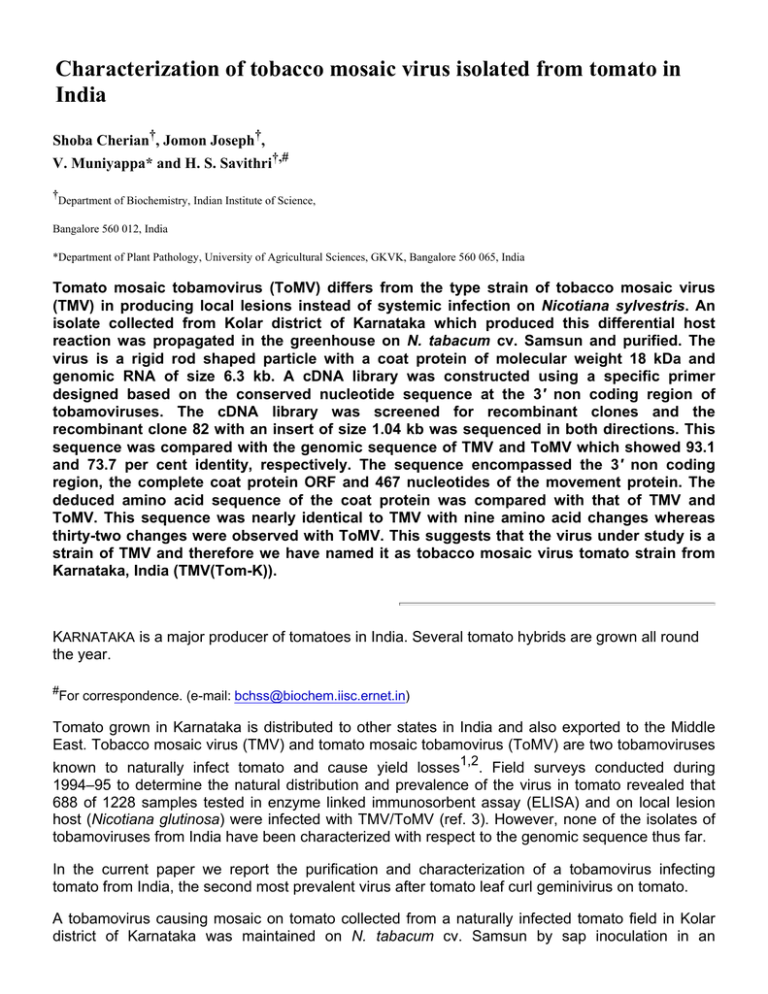
Characterization of tobacco mosaic virus isolated from tomato in India Shoba Cherian†, Jomon Joseph†, V. Muniyappa* and H. S. Savithri†,# † Department of Biochemistry, Indian Institute of Science, Bangalore 560 012, India *Department of Plant Pathology, University of Agricultural Sciences, GKVK, Bangalore 560 065, India Tomato mosaic tobamovirus (ToMV) differs from the type strain of tobacco mosaic virus (TMV) in producing local lesions instead of systemic infection on Nicotiana sylvestris. An isolate collected from Kolar district of Karnataka which produced this differential host reaction was propagated in the greenhouse on N. tabacum cv. Samsun and purified. The virus is a rigid rod shaped particle with a coat protein of molecular weight 18 kDa and genomic RNA of size 6.3 kb. A cDNA library was constructed using a specific primer designed based on the conserved nucleotide sequence at the 3' non coding region of tobamoviruses. The cDNA library was screened for recombinant clones and the recombinant clone 82 with an insert of size 1.04 kb was sequenced in both directions. This sequence was compared with the genomic sequence of TMV and ToMV which showed 93.1 and 73.7 per cent identity, respectively. The sequence encompassed the 3' non coding region, the complete coat protein ORF and 467 nucleotides of the movement protein. The deduced amino acid sequence of the coat protein was compared with that of TMV and ToMV. This sequence was nearly identical to TMV with nine amino acid changes whereas thirty-two changes were observed with ToMV. This suggests that the virus under study is a strain of TMV and therefore we have named it as tobacco mosaic virus tomato strain from Karnataka, India (TMV(Tom-K)). KARNATAKA is a major producer of tomatoes in India. Several tomato hybrids are grown all round the year. # For correspondence. (e-mail: bchss@biochem.iisc.ernet.in) Tomato grown in Karnataka is distributed to other states in India and also exported to the Middle East. Tobacco mosaic virus (TMV) and tomato mosaic tobamovirus (ToMV) are two tobamoviruses known to naturally infect tomato and cause yield losses1,2. Field surveys conducted during 1994–95 to determine the natural distribution and prevalence of the virus in tomato revealed that 688 of 1228 samples tested in enzyme linked immunosorbent assay (ELISA) and on local lesion host (Nicotiana glutinosa) were infected with TMV/ToMV (ref. 3). However, none of the isolates of tobamoviruses from India have been characterized with respect to the genomic sequence thus far. In the current paper we report the purification and characterization of a tobamovirus infecting tomato from India, the second most prevalent virus after tomato leaf curl geminivirus on tomato. A tobamovirus causing mosaic on tomato collected from a naturally infected tomato field in Kolar district of Karnataka was maintained on N. tabacum cv. Samsun by sap inoculation in an insect-proof glasshouse. The virus under study was purified from infected N. tabacum cv. Samsun leaves using the method of Asselin and Zaitlin4. Purified viral samples applied on carbon-coated grids were stained with 1% uranyl acetate and examined under a JEOL 100CX transmission electron microscope. The viral coat protein was analysed by SDS-PAGE as described by Laemmli5. The gel was stained with coomassie blue. Molecular weights were determined by plotting log molecular weight against migration distance using a set of marker proteins (Dalton Mark VII – L, SDS – 7, Sigma). Viral RNA was isolated from purified virus essentially by the method of Murant et al.6. Purified virus was incubated with an equal volume of RNA extraction buffer (0.1 M Tris, 0.01 M EDTA, 2% SDS, pH 7.5) at 55°C for 10 min. Following phenol–chloroform extraction, RNA was precipitated by adding 1/10 volume of sodium acetate and 0.8 volume of isopropyl alcohol. The isolated RNA was then run on a 1% agarose gel. Physalis mottle virus RNA of 6 kb and Sesbania mosaic virus RNA of 4.5 kb were used as markers. Antisera were produced in rabbits against purified virions of the virus under study by giving three intramuscular injections in Freund’s incomplete adjuvant at weekly intervals and one intravenous injection without the adjuvant in the fourth week. Serum was collected every week starting a week after the last injection. Antiserum titre was determined by ELISA. Double antibody sandwich ELISA (DAS–ELISA) was performed as follows. Next, the procedure of Clark and Adams7 was employed and the concentration of the protein (g -globulin) was adjusted to 1 mg/ml (A 280 nm = 1.4) and then conjugated with penicillinase (from Hindustan Antibiotics Ltd.) at an enzyme: globulin ratio of 2:1 in the presence of 0.06% glutaraldehyde. Flat-bottomed polystyrene micro titre plates (Corning, Sigma) were pre-coated with 100 m l (100 ng) of g -globulin in carbonate buffer pH 9.6. After 3h, the plates were blocked with 5% dried milk powder in PBS, coated with antigen from infected leaves (1 g/10 ml) extracted in phosphate buffered saline tween-20-poly vinyl pyrrolidone-ovalbumin (PBST–PVP–OA). Following overnight incubation and washing, the antigen was detected using penicillinase conjugated globulins of homologous antiserum at 1:1000 dilution. The substrate (2 mg sodium penicillin-G/ml bromothymol blue + 0.2 M NaOH, pH 7.2) was added and the disappearance of the blue colour at 620 nm was monitored. The polyclonal antiserum to the virus was also used for penicillinase-based direct antigen coating ELISA (DAC- ELISA) which was done as described by Sudarshana and Reddy8. Micro titre plates were coated with antigen (infected leaf extract 1 g/10 ml) extracted in carbonate buffer pH 9.6 and diluted to 1:10. Following overnight incubation at 4° C, the plates were coated with crude antiserum diluted in PBST-PVP-OA cross-adsorbed with healthy leaf extract. Fc-specific anti-rabbit penicillinase conjugate was then added followed by the addition of the substrate (2 mg sodium penicillin-G/ml of bromothymol blue + 0.2 M NaOH, pH 7.2). Using a specific primer synthesized corresponding to the 24 bases at the 3¢ end of TMV RNA (3¢ GGG CC/AT/A TGG GGG CCA A/TCC CCG GGT 5¢ ) the first strand cDNA was synthesized essentially following the protocol described by Sambrook et al.9. This first strand cDNA was then used as a template for the second strand synthesis. Following gel filtration, the cDNA fractions were cloned in the HincII site of pUC 19 cloning vector. After ligation, the DNA was transformed in competent DH 5a cells and spread on LB-Amp-X gal-IPTG plates. The colonies were initially screened by blue/white selection and later by plasmid isolation and restriction digestion with XbaI and HindIII. Initially, the sequencing of the clone was performed manually by Sanger’s dideoxy chain termination method10. The clone was later sequenced using a Perkin–Elmer ABI Prism DNA sequencer. Nucleic acid and deduced amino acid sequences were analysed using the ‘GCG’ program package at the Bioinformatics Centre, IISc. The viral sequence determined was compared and aligned with the other tobamoviral sequences in the GenBank and EMBL data base using the ‘FASTA’ and ‘GAP’ programs. The program ‘CLUSTALW’ was used to generate multiple alignment11. The aligned sequences were analysed with the ‘PHYLIP’ package of programs12,13 to infer phylogenies and to place a confidence limit on the phylogeny. The program ‘SEQBOOT’ was used to Figure 1. a, Electron micrograph of purified TMV (Tom-K) particles visualized by negative staining with 1% w/v uranyl acetate; b, Electrophoresis of the TMV (Tom-K) coat protein in 10% SDS-polyacrylamide gel stained with coomassie brilliant blue. Lane 1: Markers Type VII-L (Sigma) from top to bottom – bovine albumin (66,000); albumin egg (45,000), glyceraldehyde 3 – phosphate dehydrogenase (36,000); carbonic anhydrase (29,000); trypsinogen (24,000); trypsin inhibitor (20,100) and lactalbumin (14,200); Lane 2: Coat protein of TMV (Tom-K); c, Electrophoresis of TMV (Tom-K) RNA in 1% agarose gel stained with ethidium bromide. Lane 1: Sesbania mosaic virus RNA (4.5 kb). Lane 2: TMV (Tom-K) RNA. Lane 3: Physalis mottle virus RNA (6.2 kb). produce 100 bootstrap14 replacement sequence alignments from the original ‘CLUSTALW’ aligned sequences. The bootstrapped samples were analysed by the maximum parsimony method using the program ‘PROTPARS’. The trees produced by ‘PROTPARS’ were analysed by the program ‘CONSENSE’ to deduce a consensus tree. The unrooted phylogenetic tree was drawn using the program ‘DRAWTREE’. The virus under study was transmitted mechanically from tomato to tomato and tobacco with an efficiency of 100%. It induced mild to severe form of mosaic in tomato. Infected tobacco leaves showed light and dark green mottling, together with distortion and smaller size. The virus produced necrotic local lesions on Datura metel, D. stramonium, Gomphrena globosa, Nicotiana tabacum cvs. White Burley, Riwaka-1, L-1158, CTRI special, N. glutinosa and N. sylvestris. It produced chlorotic local lesions on Chenopodium amaranticolor. It may be noted that TMV gives systemic infection of N. sylvestris whereas ToMV produces necrotic lesions15,16. When the same inoculum of the virus under study obtained from N. tabacum cv. Samsun was inoculated to Figure 2. Nucleotide sequence of the 3¢ terminal 1048 nucleotides of TMV (Tom-K). The start and stop codons of the coat protein ORF and the sequence of the primer used to generate the cDNA clones are underlined. Figure 3. Phylogenetic analysis of tobamoviral coat protein. The dendrogram represents the consensus relationship obtained from 100 bootstrap samples for CP sequences. The number at the branch nodes indicate the number of times a particular branch appeared in all the trees that were used to determine the consense tree. N. glutinosa leaves of different sizes, they produced widely varying lesion numbers. But mean lesions/cm2 were similar and varied from 6.09 to 6.88. Figure 4. Comparison of the deduced amino acid sequence of the coat protein of TMV (Tom-K) with TMV strain vulgare and ToMV. Conservative substitutions are indicated by . or :; * indicates identities. Purified virion preparations gave an yield of 80 mg/100 g of leaf tissue, assuming an extinction coefficient of 3.1 for a 0.1% solution at 260 nm. The ultraviolet absorption spectrum of the purified virus showed maximum absorption at 260 nm. The A260/A280 ratio of the virus was close to 1.2. Electron microscopy of purified virions of the virus under study showed that the particles were rigid rods measuring 300 ´ 18 nm in size (Figure 1 a). The CP of the virus was shown to have a molecular weight of 18,000 daltons (Figure 1 b). The virus was found to consist of a single species of RNA which moved the same distance as physalis mottle virus RNA of molecular weight 2 ´ 106 daltons when subject to agarose gel electrophoresis (Figure 1 c). The protein and nucleic acid molecular weights determined for the Kolar viral isolate agree with those reported in literature17–19. The polyclonal antiserum produced against the virus under study reacted with the infected sap and the purified virus to give titres of 1/10,000 and 1/32,000, respectively, in penicillinase-based DAS-ELISA. The penicillinase globulin conjugate had a titre of 1/2000 when tested in DAS–ELISA. Table 1 (ELISA results) shows that the virus can be detected in infected leaf extracts in the dilution range of 10–1 (1.14) to 10–7 (0.054) using an antiserum dilution of 1:1000. In comparison, the local lesion host N. glutinosa detected the virus in tomato leaf extracts diluted up to 10–6. Among the recombinant clones generated, clone 82 released an insert of size 1.04 kb upon digestion with XbaI and HindIII. Automated DNA sequencing of this clone in both the directions resulted in the sequence of the 3¢ terminal 1048 nucleotides of the virus (Figure 2). Comparison of this sequence with other members of the tobamovirus group showed that this sequence aligned at nucleotide 5711 of TMV and ended at 6395, the 3¢ terminal nucleotide of TMV20. It is interesting to note that the sequence obtained matched well with that of TMV (93.1% identity) whereas it had much less homology with ToMV (73.7% identity). This suggests that though this isolate produces local lesion on N. sylvestris, it is a strain of TMV and not a strain of ToMV. This is further supported by the data presented in Table 2 which depicts the per cent identity of the coat protein and 3¢ noncoding region of the present isolate with other tobamoviruses. Figure 3 shows the dendrogram of the tobamoviral CP sequences. Even here TMV (Tom-K) clusters with TMV CP rather than with ToMV CP. Comparison of the CP sequence of TMV (Tom-K) with the TMV strain vulgare20 showed that there are 9 amino acid changes between TMV CP and that of the Indian isolate (Figure 4). Out of these, 5 of the changes are conservative substitutions. On the other hand, 32 amino acid changes were observed between TMV (Tom-K) and ToMV21. Thus the analysis of the 3¢ terminal nucleotides of the Indian isolate clearly establishes that the isolate is a strain of tobacco mosaic and hence is called tobacco mosaic virus tomato strain (TMV (Tom-K)). The nucleotide sequence reported in this paper has been submitted to GenBank and assigned the accession number AF 126505. 1. 2. 3. 4. 5. 6. 7. 8. 9. 10. 11. 12. 13. 14. 15. 16. 17. 18. 19. 20. 21. 22. 23. 24. 25. Rao, M. H. P. and Reddy, D. V. R., Indian Phytopathol., 1971, 24, 672–678. Giri, B. K. and Mishra, M. D., Indian Phytopathol., 1990, 43, 487–490. Shoba Cherian and Muniyappa,V., Indian J. Virol., 1998, 14, 65–69. Asselin, A. and Zaitlin, N., Virology, 1978, 88, 191–193. Laemmli, U. K., Nature, 1970, 227, 680–685. Murant, A. F., Taylor, M., Duncan, G. H. and Raschke, J. H., J. Gen. Virol., 1981, 53, 321–332. Clark, M. F. and Adams, A. N., J. Gen. Virol., 1977, 34, 475–483. Sudarshana, M. R. and Reddy, D. V. R., J. Virol. Methods, 1989, 26, 45–52. Sambrook, J., Fritsch, E. F. and Maniatis, T., Molecular Cloning – A Laboratory Manual, Cold Spring Harbor Laboratory Press, USA, 1989, 2nd ed. vol. 1–3. Sanger, F., Nicklen, S. and Coulson, A. R., Proc. Natl. Acad. Sci. USA, 1977, 74, 5463–5467. Thompson, J. D., Higgins, D. G. and Gibson, T. J., Nucleic Acids Res., 1994, 22, 4673–4680. Felsenstein, J., Annu. Rev. Genet., 1988, 22, 521–565. Felsenstein, J., Cladistics, 1989, 5, 164. Felsenstein, J., Evolution, 1985, 39, 783. VanRegenmortel, M. H. V., in Handbook of Plant Virus Infections and Comparitive Diagnosis (ed. Krustak, K.), Elsevier, Amsterdam, 1981, p. 541. Wang, A. L. and Knight, C. A., Virology, 1967, 31, 101–106. Bem, F. and Murant, A. F., J. Gen. Virol., 1979, 44, 817–826. Murant, A. F. and Taylor, M., J. Gen. Virol., 1978, 41, 53–61. Rejinders, L., Aalbers, A. M. J. and Van Kammun, A., Virology, 1974, 69, 515–521. Goelet, P., Lomonossoff, G. P., Butter, P. J. G., Akem, M. E., Gait, M. J. and Karn, J., Proc. Natl. Acad. Sci. USA, 1982, 79, 5818–5822. Ohno, T., Aoyagi, M., Yamanashi, Y., Saito, H., Ikawa, S., Meshi, T. and Okada, Y., J. Biochem., 1984, 96, 1915–1923. Isomura, Y., Matumoto, Y., Murayama, A., Chatani, M., Inouyee, N. and Ikegami, M., J. Gen. Virol., 1991, 72, 2247–2249. Alonso, E., Garcia-Luque, I., de la Cruz, A., Wicke, B., Avila-Rincon, M. J., Serra, M. T., Castresana, C. and Diaz-Ruiz, J. R., J. Gen. Virol., 1991, 72, 2875–2884. Nejidat, A., Cellier, F., Holt, C. A., Gafny, R., Eggenberger, A. L. and Beachy, R. N., Virology, 1991, 180, 318–326. Ugaki, M., Tomiyama, M., Kakutani, T., Hidaka, S., Kiguchi, T., Nagata, R., Sato, T., Motoyoshi, F. and Nishiguchi, M., J. Gen. Virol., 1991, 72, 1487–1495. ACKNOWLEDGEMENTS. This work was supported by CSIR and DBT, New Delhi, India. We also thank DBT for providing the Bioinformatics and Automated DNA sequencing facilities. We thank Mr P. Elango, Ms Savitha and Ms H. A. Prameela, for all the help rendered. Received 19 December 1998; revised accepted 12 March 1999
